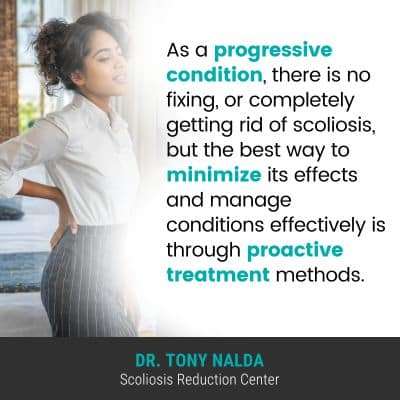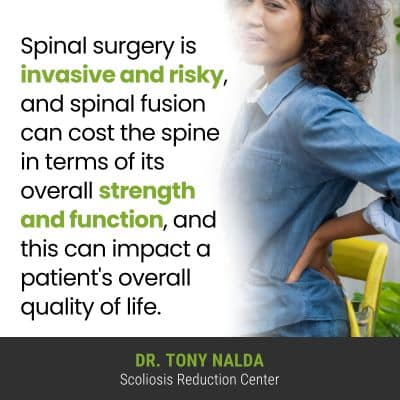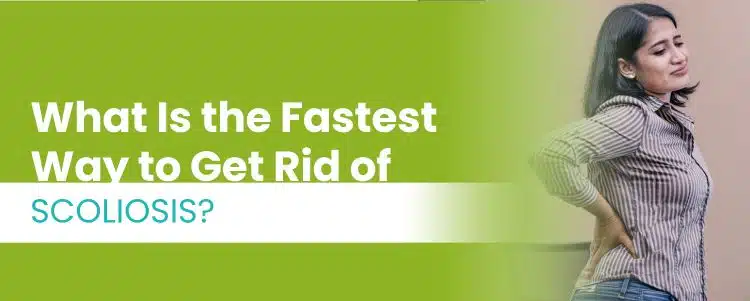The best way to manage life with scoliosis is through a conservative and proactive treatment approach that’s started as close to the time of diagnosis as possible. The milder scoliosis is at the start of treatment, the easier it is to correct.
As a progressive condition, there is no getting rid of scoliosis; treatment is about managing a life-long condition. The best way to minimize the effects of scoliosis is to treat it proactively, and that means the sooner conditions are diagnosed and treated, the more responsive they are likely to be.
The fastest way to manage scoliosis effectively is through proactive treatment, but before discussing treatment, let’s touch on some important condition characteristics.
Understanding Scoliosis
When it comes to scoliosis, it’s important to understand that it’s a 3-dimensional spinal condition because it doesn’t just cause an unnatural sideways-bending curve to develop, it also causes the spine to rotate.
In addition, scoliosis is progressive by nature, meaning its nature is to get worse over time, and that means the size of the unnatural spinal curve is increasing, as are the condition’s uneven forces, and their effects.
In children, the main effects involve postural changes caused by the condition disrupting the body’s overall symmetry, and this can include uneven shoulders, uneven shoulder blades, the development of a rib cage arch, arms and legs that hang at different lengths, and disruptions to balance, coordination, and gait are also common.
In adults, for whom scoliosis is compressive, pain is the main condition effect, and again, these effects will get worse alongside progression, so where a scoliosis is at the time of diagnosis doesn’t mean that’s where it will stay.
Condition Severity and Type
The complex nature of scoliosis necessitates the complete customization of treatment plans, and this is because no two cases of scoliosis are the same; not only does scoliosis range so widely in severity from mild scoliosis, moderate scoliosis, severe, and very severe scoliosis, there are also different condition types.
Condition type is determined by causation, and the most common type of scoliosis to affect all ages is idiopathic scoliosis: not clearly associated with a single-known cause.
Approximately 80 percent of scoliosis cases are idiopathic, while the remaining 20 percent are associated with known causes: neuromuscular scoliosis, degenerative scoliosis, and congenital scoliosis.
Neuromuscular scoliosis is caused by the presence of a larger neuromuscular condition like spina bifida, cerebral palsy, and muscular dystrophy.
Degenerative scoliosis affects older adults and is caused by natural age-related spinal degeneration, and congenital scoliosis develops in utero as the spine forms atypically.
So now that we have a basic understanding of scoliosis and what makes it unique and challenging to treat, let’s address the difference between modern proactive scoliosis treatment and a traditional reactive approach.

As a progressive condition, there is no fixing, or completely getting rid of scoliosis, but the best way to minimize its effects and manage conditions effectively is through proactive treatment methods.
Modern Conservative Scoliosis Treatment is Proactive
There was a time when patients only had one treatment option presented to them, but that has since changed, and there is now a modern approach to scoliosis treatment that offers patients a nonsurgical alternative.
Here at the Scoliosis Reduction Center®, patients benefit from a proactive conservative treatment approach that’s started as close to the time of diagnosis as possible; this is important because the more scoliosis progresses, the more complex it is to treat.
As the size of a scoliotic curve gets larger with progression, the spine becomes increasingly rigid, making it less responsive to treatment and making it difficult for some patients to perform therapeutic exercises as part of treatment.
Conservative treatment is also integrative; it combines multiple scoliosis-specific treatment disciplines so conditions can be impacted on every level: chiropractic treatment, physical therapy, corrective bracing, corrective exercises, and rehabilitation.
Chiropractic Care
As a structural spinal condition, scoliosis has to, first and foremost, be impacted on a structural level, and that means reducing the size of the scoliotic curve, and this can be worked towards through a series of chiropractic techniques and manual adjustments that work together to realign the spine.
Manual adjustments can reposition the curve’s most-tilted vertebrae at its apex back into alignment with the rest of the spine, and this doesn’t just improve the health of the spine itself, but also the spine’s surrounding muscles and nerves.
Once the spine is impacted structurally in the form of a curve reduction, I can shift the focus.
Physical Therapy and Corrective Exercises
Physical therapy for scoliosis complements chiropractic care by working towards increasing core strength so the spine is optimally supported and stabilized by its surrounding muscles.
Physical therapy can also help by addressing any related muscle imbalance and improving posture; corrective exercises also help with these areas of focus by stimulating certain areas of the brain for improved brain-body communication.
A scoliosis muscular imbalance can develop as the muscles on either side of the spine struggle to support it while being pulled in different directions by the unnatural spinal curve; muscles on one side can become overused and sore, while muscles on the opposite side can become weak from underuse.
Physical therapy and corrective exercises also help with keeping the spine flexible and loose, as well as keeping the spine’s surrounding muscles loose, balanced, and strong.
Corrective Bracing
Corrective bracing is what patients of the Center benefit from, and as bracing is particularly effective on growing spines, it’s a regular facet of treatment for childhood scoliosis.
The modern ultra-corrective ScoliBrace is my brace of choice as part of conservative treatment because it represents the culmination of what we’ve learned about scoliosis and bracing efficacy.
The ScoliBrace pushes the spine into a straighter alignment, and when combined with other forms of corrective treatment, it can augment corrective treatment results.
Rehabilitation
Rehabilitation is the ongoing phase of treatment that can involve continued chiropractic care and the prescription of scoliosis-specific exercises that can be performed from home to hold results and further stabilize the spine.
Continued chiropractic care can help sustain a curvature reduction, and corrective exercises can keep the spine loose and strong.
Traditional Scoliosis Treatment is Reactive
Traditional scoliosis treatment was the dominant treatment choice for many years, but that doesn’t mean it’s the best, nor only treatment plan available, and the evolution of conservative nonsurgical treatment shows that not all cases of scoliosis require surgical intervention.
Traditional scoliosis treatment is reactive because it doesn’t have a strategy for addressing scoliosis while mild, when it’s most treatable, so instead commonly recommends watching and waiting, and if a patient progresses into the moderate level, traditional bracing is the only form of treatment applied prior to a surgical recommendation.
Traditional bracing is associated with a number of shortfalls, and if a patient still progresses and becomes severe, spinal fusion surgery is commonly recommended.

Spinal surgery is invasive and risky, and spinal fusion can cost the spine in terms of its overall strength and function, and this can impact a patient’s overall quality of life.
Spinal fusion involves fusing the curve’s most-tilted vertebral bodies into one solid bone so they can’t become more tilted over time, and this commonly involves the removal of intervertebral discs between vertebrae being fused and attaching rods to the spine to hold it in place.
While spinal fusion can straighten a bent spine, many patients are disappointed with the loss in spinal flexibility and range of motion they are left with, and the psychological effect of knowing a fused spine is weaker and more vulnerable to injury shouldn’t be discounted.
Conclusion
So what is the fastest way to get rid of scoliosis? While there is no getting rid of scoliosis as in curing it, it can be managed effectively through proactive treatment capable of impacting conditions on every level.
The fastest way to see results is to start treatment as close to the time of diagnosis as possible because as a progressive condition, scoliosis is virtually guaranteed to get worse, and it’s simplest to treat while mild; however, regardless of type or severity, the best time to start scoliosis treatment is always now.
Once results are noticed, the motivation to continue with treatment is strong, and this is the best way to minimize the condition’s effects: managing it through treatment.
When the condition is impacted on a structural level, this is addressing the underlying structural nature of scoliosis for long-term sustainable results, and once a curvature reduction is achieved, conservative treatment shifts the focus to increasing core strength for improved spinal support and stabilization.
Here at the Center, I remind patients that while we don’t know what causes most cases of scoliosis to develop initially, as we know it’s growth that makes it progress, we can manage and treat it effectively.
The worst thing to do following a scoliosis diagnosis is to merely watch and wait, and this is because while being observed, patients can have a significant growth spurt that causes significant progression, making the condition’s effects more noticeable and the condition more complex to treat.
In most scoliosis cases, it’s more effective to proactively work towards preventing progression and increasing condition effects than it is to attempt to reverse them once they’re established.




